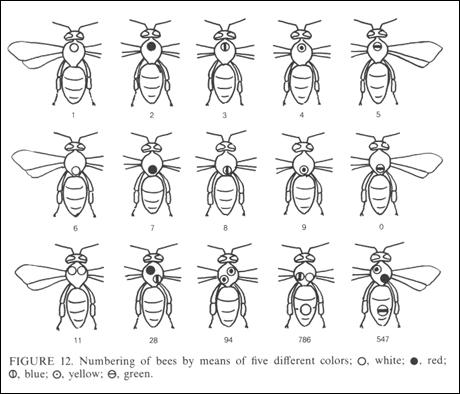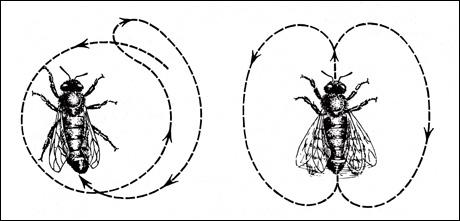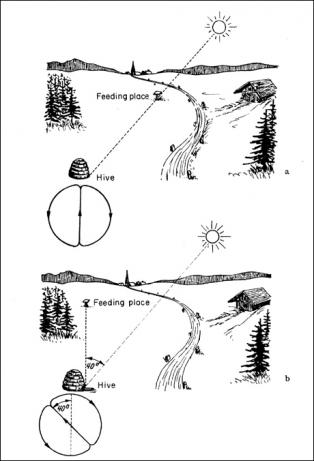Lifting the cover of a beehive reveals a teeming mass of tens of thousands of bees. For the human observer, it is impossible to tell individual animals apart, much less to follow them through the tangle of the hive. But precisely this kind of observation—at the level of the individual animal and its interactions with hive mates—was what the experimental physiologist and later Nobel Laureate Karl von Frisch (1886-1982) was after, when he devised a special bee numbering system in the early 1920s. Although the technique required nothing more than a steady hand, a brush, and paint, it would have profound consequences for how scientists would come to understand the animal-human boundary and know bees as communicating animals.
Karl von Frisch is best known today for having elucidated the honeybee dance language. By painting small dots of colored paint on the bee's thorax and abdomen, he could systematically mark and track hundreds of bees.

Fig. 1: Numbering System: A numbering system based on colored dots painted on the bee’s thorax and abdomen, allowed von Frisch to distinguish and track hundreds of bees. Source: Karl von Frisch, The Dance Language and Orientation of Bees, Harvard University Press, 1993, p. 15.
This elegant observational technique radically changed the way bees were seen; von Frisch was now able to “recognize” animals mid-flight, observe their interactions, and follow them as they moved through carefully designed experiments. Over the course of several decades, he discovered that foragers communicate to their hive mates the distance and direction of food sources by means of the circle and waggle “dances” they run upon returning from foraging flights.

Fig. 2: Left: The round dance alerts hive mates to nearby foods. Right: The tail-waggle dance indicates the distance and direction of more distant food sources. Source: Karl von Frisch, Erinnerungen eines Biologen, Berlin, Göttingen, Heidelberg: Springer, 1957, p. 128.
The straight part of the figure-eight-shaped waggle dance makes the same angle with the vertical axis of the hive as the bee made on her flight with respect to the sun.

Fig. 3: These images show how the forager bee signals the direction of food sources to her hive mates when the food is in a direct line with the sun (top) and when it is at a 40° angle from the sun. Source: Karl von Frisch, Erinnerungen eines Biologen, Berlin, Göttingen, Heidelberg: Springer, 1957, p. 129.
Moreover, he found that the frequency of individual turns correlated closely with the distance of the food; the closer the supply, the more rapidly the bees dance.
News of the discovery of a bee language was received as a sensation and quickly spread throughout Europe and abroad. Von Frisch’s work challenged existing notion of the animal-human boundary, as language had long been considered a window into human minds and souls and one of the key differences between humans and animals. From dolphin and whale song to signing chimpanzees, by the mid 1960s, a flurry of scientific activity surrounded animal communication. Honeybee language held a prominent place in this research and is examined in the larger context of twentieth-century sciences of communication in the “Dancing Bees.”
The Dancing Bees: Karl von Frisch, the Honeybee Dances, and 20th-Century Sciences of Communication is a book-length study of Karl von Frisch and the bees. It examines von Frisch’s work on honeybees over five decades and traces the transition of the bee as a cultural and scientific object. Commentators had for centuries looked to the bees as a model of how a well-run social polity might function. But now they were turning to the animals’ dances for insights into non-human communication. We are tempted to see twentieth-century linguistics as largely a consequence of the linguist Noam Chomsky’s revolutionary (and resolutely human-centric) work. However, there was a brief window during which the dream of universal communication seemed possible, when the bee was not simply a remarkable animal that was highly adapted to its environment, but a key that might unlock the gate that separated animals from humans.
As the example of the bee numbering system suggests, von Frisch promoted a particular way, not just of doing science, but also of observing and understanding animals. He was also an early and enthusiastic producer of scientific films and used them as tools for observation and demonstration. He often relied on the medium to demonstrate aspects of behavior that lay beyond its direct explanatory reach—black-and-white silent film was called upon to support arguments about the bees’ abilities to discern colors, scents, tastes, and sounds. In a 1927 film, von Frisch sought to demonstrate that the bees can perceive different scents. Here stains left behind by scented oils were called upon to indicate the presence of odors. Thus, another aspect of the project shows how von Frisch bridged the epistemic gaps of the medium by training audiences to read the invisible in the visual language of film.
By paying close attention to techniques of observation and their epistemological and ontological consequences, this work finds its institutional home at the MPI within the project “The History of Scientific Observation.” This multi-year project has welcomed the participation of 40 number of scholars and aims to create the first history of scientific observation as an epistemic category, from the high middle ages to the late twentieth century, in both the human and natural sciences.
